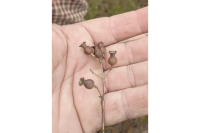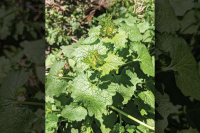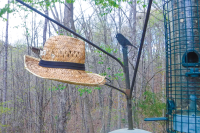A Family’s Quest to Save Their Little Girl’s Sight

When Amanda Byerly and her husband took their two-year-old daughter, Elin, to a routine eye doctor’s appointment, the last thing they expected to hear was that her child most likely had a genetic condition that could result in permanent blindness. After doing research, consulting with additional physicians and traveling to Duke to confirm the diagnosis, they discovered there actually is a cure, but it’s currently just out of reach for patients. Rumble sat down with Amanda to hear her captivating story.
Rumble: Can you give us some background on Elin's diagnosis?
Amanda: Over the summer, I noticed Elin's left eye starting to float in towards her nose ever so slightly. In fact, it was so subtle that my husband didn't even believe me at first. Eventually, we took her to the pediatrician, and they referred her to Asheville Eye for Strabismus, a fancy word for eye crossing. Her older sister, Nola (five-years old), has mild accommodative esotropia. (That means she's farsighted, and one of her eyes will ever so slightly turn in when she focuses on something up close. Fortunately, we've been able to correct her eye turn with glasses.) We took Elin to Asheville Eye on November 27th, thinking she would also probably need eyeglasses or maybe even an eye patch over the stronger eye to help strengthen the weaker eye. The appointment was going well until the doctor looked inside Elin's eyes, and that's when she said Elin had a retinal dystrophy -- in this case a blinding disease. We were absolutely devastated. I liken it to going to the doctor for a headache and finding out you have a brain tumor -- only it's happening to your child. She was referred for genetic testing and to Duke University to see a retinal disease specialist. The genetic testing results revealed that Elin has a genetic mutation on the RDH12 gene that is associated with a severe, early-onset retinal dystrophy. She went to Duke twice. The second time there, she was put under general anesthesia, and the doctor performed an ERG (which measures the electrical activity in the back of her eyes), a fluorescein angiography, and more imaging. At that point, the doctor could tell us with certainty that Elin has a classic case of early onset retinal dystrophy due to a mutation on the RDH12 gene. According to the doctor, she has 60% retinal cells remaining in her eyes and no central vision.
Rumble: How does the diagnosis affect her daily life?
Amanda: We are fortunate that so far Elin's vision problems have not affected her daily life -- at least not on the outside looking in. Prior to Elin's diagnosis, we had absolutely no clue that she just could not see. In fact, if we hadn't taken her to that first eye appointment, we STILL wouldn't know anything is wrong. She goes to a preschool three and a half days a week, and her teachers never noticed any red flags either. She keeps up well with her peers and her big sister. She can perform any fine hand-eye tasks we give her. She can spot a tiny toy on the floor from across the room, and she can spot any family member standing out in the hallway watching her at dance class. She loves to blow bubbles and then chase after them, popping each and every one she can get a hold of. She also does well in the dark. Most nights, she gets out of her "big girl bed" in the middle of the night all by herself and makes her way into our room on the opposite end of the house and up into our bed seamlessly. She also passed the visual acuity test at Duke with flying colors -- so much so that the tech told her, "You've got great eyes, girl." There may be a better medical explanation for all of this, but as her mother, I KNOW that this is a testament to God's faithfulness and handiwork in Elin. Every evening before I go to sleep I make it a point to thank God for the gift of Elin's eyesight and vision for that day.
Rumble: What is the prognosis?
Amanda: Typically, children affected with the same rare disease as Elin are legally blind by the first decade of life and completely blind by the second decade of life. It's very aggressive. Everyone has the RDH12 gene, but if you have an RDH12 gene that is not working correctly, it disrupts the visual cycle and allows a toxic waste to build up. In turn, the retinal cells silently and painlessly waste away. My husband and I have been tested now and found out that we both unknowingly had a good copy of the gene and a bad copy of the gene. Long story short, we had a 25% chance of passing both bad copies on to our offspring. While we didn't pass it on to our older daughter, Nola, we did pass it on to Elin. My brain knows that this is not our fault, but I still carry a tremendous amount of guilt about unknowingly giving this to our child.
Rumble: In your opinion, why is there a lack of awareness?
Amanda: Elin's rare disease affects 1 in 288,000 individuals and is classified as an "orphan disease." It's basically up to the patients and their families to fund the research and, ultimately, a cure. There are two companies right now that are sitting on very promising gene replacement therapies to cure the disease, but they need a lot more funding before they can take it to the clinical trial phase. Unfortunately, many pharmaceutical companies have passed on partnering with them due to what they perceive as a lack of return on investment. Essentially, they don't feel like the commercial case is strong enough. I should note, however, that most gene replacement therapies on the market start at $1 million for a single treatment and the sky really is the limit in terms of what they can charge.
Prior to Elin's diagnosis, I had no idea this disease existed. Neither did any of our friends or family. It's been so hard not only trying to explain the disease itself but also to garner genuine empathy from most, given that the disease will likely never affect them or anyone that they know. It kind of feels like Elin and the others diagnosed with this disease have been forgotten by society as a whole. It's also extra challenging because this disease only affects Elin's eyes. It's not a life-threatening condition, she has no developmental delays, and she can run around with the best of them. While I am grateful for all of those things, it does feel like a part of her is dying. Unless a treatment becomes readily available soon, we, as her parents, have to sit back and watch her world grow a little smaller and darker each and every day. I can't even begin to explain the amount of pain and sadness that causes me. There are truly no words.
Rumble: What would you like readers to know and how can we help?
Amanda: Elin and the others affected by her rare disease are fearfully and wonderfully made. They are deserving of a cure and a full life just like anyone else. If you would like to support Elin and the others affected by this devastating disease, please consider donating to The RDH12 Foundation. https://www.rdh12sight.org/fundraising-giving









